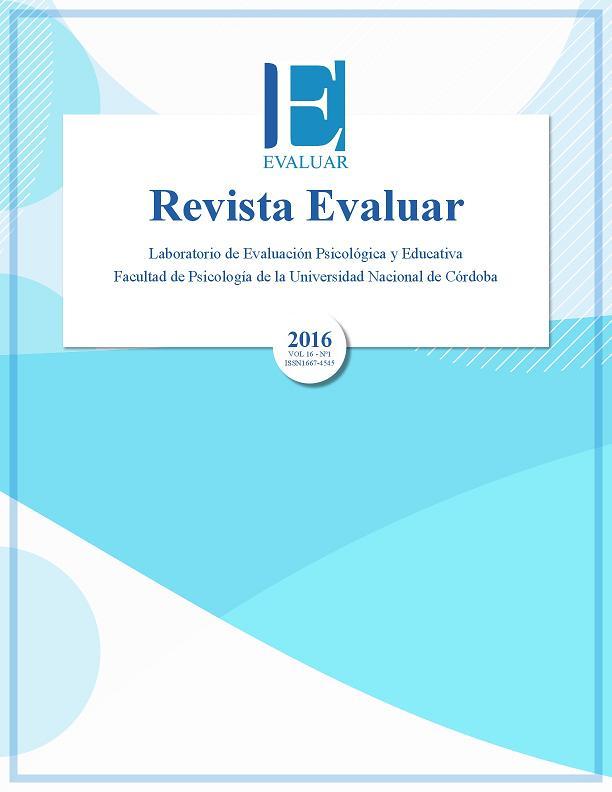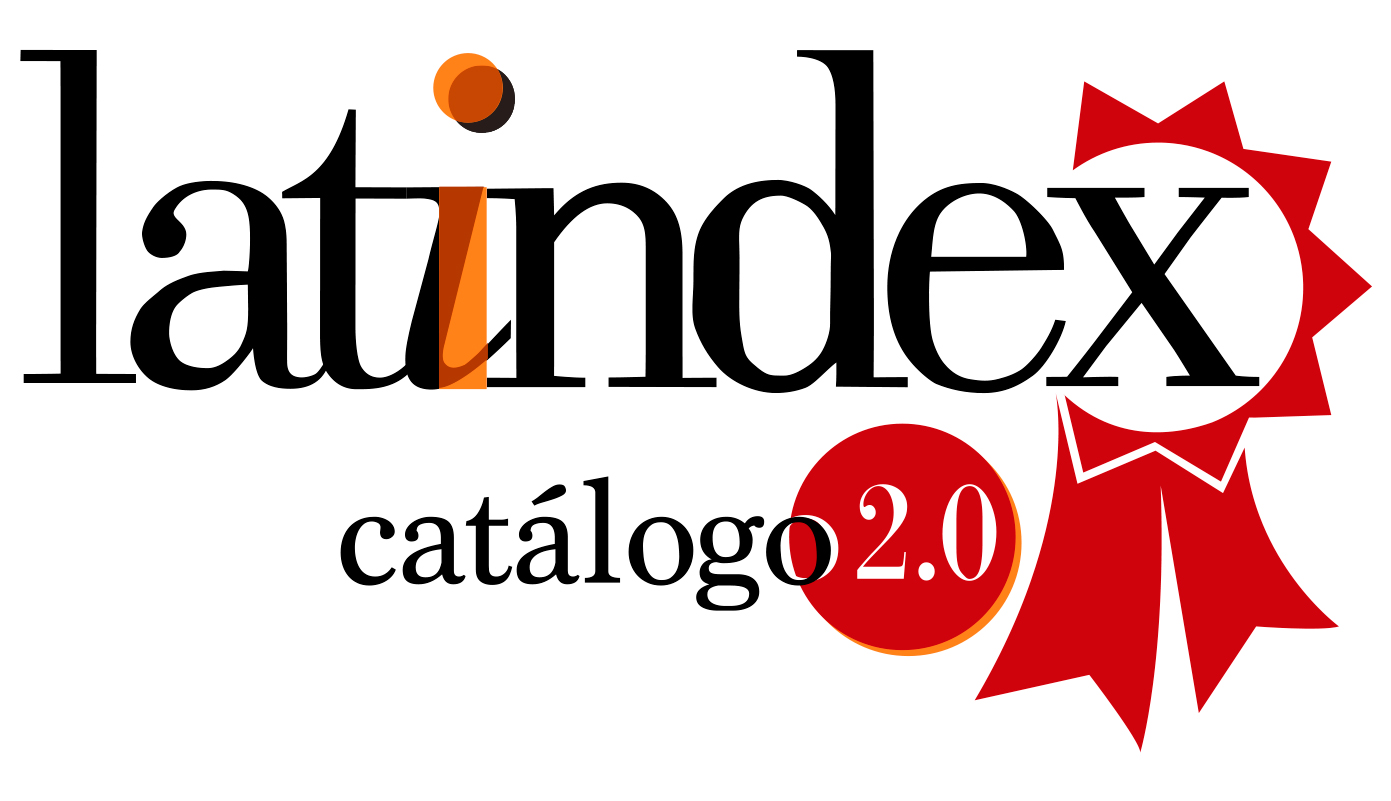Psychometric study of the CARLOS (CRAFFT) instrument in Mexican university students.
DOI:
https://doi.org/10.35670/1667-4545.v16.n1.15756Keywords:
CARLOS (CRAFFT), Psychoactive Substances, Screening, Mexican University StudentsAbstract
In México there are instruments with adequate psychometric properties evaluating alcohol consumption, as well as several aspects of its use and risk perception (refer to Calleja, 2011). However, so far, a scale measuring both alcohol consumption and other psychoactive substances in a brief and precise way has not been validated in México. This study aimed to examine the psychometric properties of the CARLOS (CRAFFT) instrument by Knight, Sherrit, Shrier, Harris and Chang (2002) in a sample of 220 Mexican university students. The instruments CARLOS (CRAFFT) and AUDIT were applied to Mexican university students. The self-administered test technique was used and the instruments were applied inside the classroom. A 1 was assigned to an affirmative answer and 0 for a negative answer. The average age of the participants was 20 years (range, 18 to 25 years). The CARLOS (CRAFFT) instrument showed moderately high internal consistency levels (Cronbach’s alpha = .73). The cutoff point of 2 offers the best combination of sensibility (.86) and specificity (.73) with a positive predictive value (.52) and a negative predictive value (.93). The area under the ROC curve was .79 and Pearson’s r correlation between the CARLOS (CRAFFT) and the AUDIT instrument was .67 (p < 0.01). The CARLOS (CRAFFT) instrument is sufficiently valid and reliable for testing psychoactive substances consumption in Mexican university students.Downloads
References
Aiken, L. R. (2003). Test psicológicos y evaluación (10ª ed.). México: Pearson Educación.
Argibay, J. C. (2009). Muestra en investigación cuantitativa. Subjetividad y Procesos Cognitivos, 13(1), 13-29. Recuperado de http://dspace.uces.edu.ar:8180/xmlui/handle/123456789/719
Babor, T., Higgins-Biddle, J., Saunders, J., & Monteiro, M. 2001). AUDIT Cuestionario de identificación de los trastornos debidos al consumo de alcohol: Pautas para su utilización en atención primaria. Suiza: Organización Mundial de la Salud, Departamento de Salud Mental y Dependencias de Sustancias.
Bernard, M., Bolognini, M., Plancherel, B., Chinet, L., Laget, J., Stephan, P., & Halfon, O. (2005). French validity of two substance-use screening tests among adolescents: A comparison of the CRAFFT and DEPADO. Journal of Substance Use, 10(6), 385-395. doi: 10.1080/14659890412331333050
Bertini, M. C., Busaniche, J., Baquero, F., Eymann, A., Krauss, M., Paz, M., & Catsicaris, C. (2014). Adaptación transcultural y validación del test CRAFFT como prueba de pesquisa para consumo problemático, abuso y dependencia de alcohol y otras sustancias en un grupo de adolescentes argentinos. Recuperado de http://www.sap.org.ar/docs/publicaciones/primero/2015/AO_Bertini_anticipo_12-2-15.pdf
Byrne, B. M. (2010). Structural Equation Modeling with AMOS: Basic Concepts, Applications and Programming (2a ed.). Routledge, Taylor & Francis Group: New York, NY.
Calleja, N. (2011). Inventario de escalas psicosociales en México 1984-2005. México: UNAM, Facultad de Psicología.
Campos-Arias, A., & Oviedo, H. C. (2008). Propiedades psicométricas de una escala: La consistencia interna. Revista Salud Pública, 10(5), 831-839. doi: 10.1590/s0124-00642008000500015
Clark, D. B., Gordon, A. J., Ettaro, L. R., Owens, J. M., & Moss, H. B. (2010). Screening and brief intervention for underage drinkers. Mayo Clinic Proceedings, 85(4), 380-391. doi: 10.4065/mcp.2008.0638
Cook, R. L., Chung, T., Kelly, T. M., & Clark, D. B. (2005). Alcohol screening in Young persons attending a sexually transmitted disease clinic. Journal of General Internal Medicine, 20(1), 1-6. doi: 10.1111/j.1525-1497.2005.40052.x
Cote-Menendez, M., Uribe-Isaza, M. M., & Prieto-Suárez, E. (2013). Validación para Colombia de la escala Crafft para tamización de consumo de sustancias psicoactivas en adolescentes. Revista de Salud Pública 15(2), 220-232. Recuperado de http://revistas.unal.edu.co/index.php/revsaludpublica
Cuevas-Renaud, C., & Alejo-Martínez, A. (2010). Validez y fiabilidad de medidas de exposición y medición. México: UNAM, Recuperado de http://www.psicol.unam.mx/Investigacion2/pdf/SENSIBILIDAD%20Y%20ESPECIFICIDAD.pdf
Cummins, L. H., Chan, K. K., Burns, K. M., Blume, A. W., Larimer, M., & Marlatt, G. A. (2003). Validity of the CRAFFT in American-Indian and Alaska-Native adolescents: Screening for drug and alcohol risk. Journal of Studies on Alcohol, 64(5), 727-32. doi: 10.15288/jsa.2003.64.727
Dhalla, S., Zumbo, B. D., & Poole, G. (2011). A review of the psychometric properties of the CRAFFT instrument: 1999-2010. Current Drug Abuse Review, 4(1), 57-64. doi: 10.2174/1874473711104010057
Encuesta Nacional de Adicciones (2011). Drogas ilícitas. Recuperado de http://www.conadic.salud.gob.mx/pdfs/ENA_2011_DROGAS_ILICITAS_.pdf
Hanley, J. A., & McNeil, B. J. (1982). The meaning and use of the area under a receiver operating characteristic (ROC) curve. Radiology, 143(1), 29-36. doi: 10.1148/radiology.143.1.7063747
Kandemir, H., Aydemir, Ö., Ekinci, S., Selek, S., Kandemir, S. B., & Bayazit, H. (2015). Validity and reliability of the Turkish version of CRAFFT substance abuse screening test among adolescents. Neuropsychiatric Disease and Treatment, 11, 1505-1509. doi: 10.2147/ndt.s82232
Knight, J. R., Sherritt, L., Shrier, L. A., Harris, S. K., & Chang, G. (2002). Validity of the CRAFFT substance abuse screening test among adolescent clinic patients. Archives on Pediatric and Adolescent Medicine, 156(6), 607-614. doi: 10.1001/archpedi.156.6.607
Kramarová, L., Kluso?ová, H., Petrelli, F., & Grappasonni, I. (2011). Tobbaco, alcohol and ilegal substances: Experiences and attitudes among Italian university students. Revista da Associação Médica Brasileira, 57(5), 513-518. doi: 10.1016/s0104-4230(11)70105-1
Mitchell, S. G., Kelly, S. M., Gryczynski, J., Myers, C. P., O ´Grady, K. E., Kirk, A. S., & Schwartz, R. P. (2014). The CRAFFT cut-points and DSM-5 criteria for alcohol and other drugs: A re-evaluation and re-examination. Substance Abuse, 35(4), 376-380. doi: 10.1080/08897077.2014.936992
Pérez-Gómez, A., & Scopetta-Díaz-Granados, O. (2011). El CRAFFT/CARLOS como instrumento para la identificación temprana de consumo de alcohol y otras SPA: Una adaptación al español. Revista Colombiana de Psicología, 20(2), 265-274. Recuperado de http://revistas.unal.edu.co/index.php/psicologia
Rubio, G. (1998).Validación de la prueba para la identificación de trastornos por el uso de alcohol (AUDIT) en atención primaria. Revista Clínica Especializada, 198, 11-14.
Skogen, J. C., Bøe, T., Knudsen, A. K., & Hysing, M. (2013). Psychometric properties and concurrent validity of the CRAFFT among Norwegian adolescents. Ung@hordaland, a population based study. Addictive Behaviors, 38(10), 2500-2505. doi: 10.1016/j.addbeh.2013.05.002
Subramaniam, M., Cheok, C., Verma, S., Wong, J., & Chong, S. A. (2010). Validity of a brief screening instrument-CRAFFT in a multiethnic Asian population. Addictive Behaviors, 35(12), 1102-4. doi: 10.1016/j.addbeh.2010.08.004
Tossmann, P., Kasten, L., Lang, P., & Strüber, E. (2009). Determination of the concurrent validity of the CRAFT-d– A screening instrument for problematic alcohol consumption. Zeitschrift für Kinder und Jugendpsychiatrie Psychotherapie, 37(5), 451-459. doi: 10.1024/1422-4917.37.5.451
United Nations Office on Drugs and Crime (2013). World Drug Report. Recuperado de http://www.unodc.org/unodc/secured/wdr/wdr2013/World_Drug_Report_2013.pdf
Villatoro, J., Medina-Mora, M. E., Fleiz-Bautista, C., Moreno-López, M., Oliva-Robles, N., Bustos-Garmiño, M., ... Amador-Buenabad, N. (2012). El consumo de drogas en México: Resultados de la Encuesta Nacional de Adicciones, 2011. Salud Mental, 35(6), 447-457. Recuperado de http://revistasaludmental.mx/index.php/salud_mental
Downloads
Published
How to Cite
Issue
Section
License
Copyright (c) 2016 Gloria Velia Reyna Barajas, Luis Fernando Copertari Isaacson, Fabiola González Betanzos, Ferran Padrós Blàzquez

This work is licensed under a Creative Commons Attribution 4.0 International License.
Revista Evaluar aplica la Licencia Internacional de Atribuciones Comunes Creativas (Creative Commons Attribution License, CCAL). Bajo esta licencia, los autores retienen la propiedad de copyright de los artículos pero permiten que, sin que medie permiso de autor o editor, cualquier persona descargue y distribuya los artículos publicados en Evaluar. La única condición es que siempre y en todos los casos se cite a los autores y a la fuente original de publicación (i.e. Evaluar). El envío de artículos a Evaluar y la lectura de los mismos es totalmente gratuito.




_(3).jpg)



.jpg)



